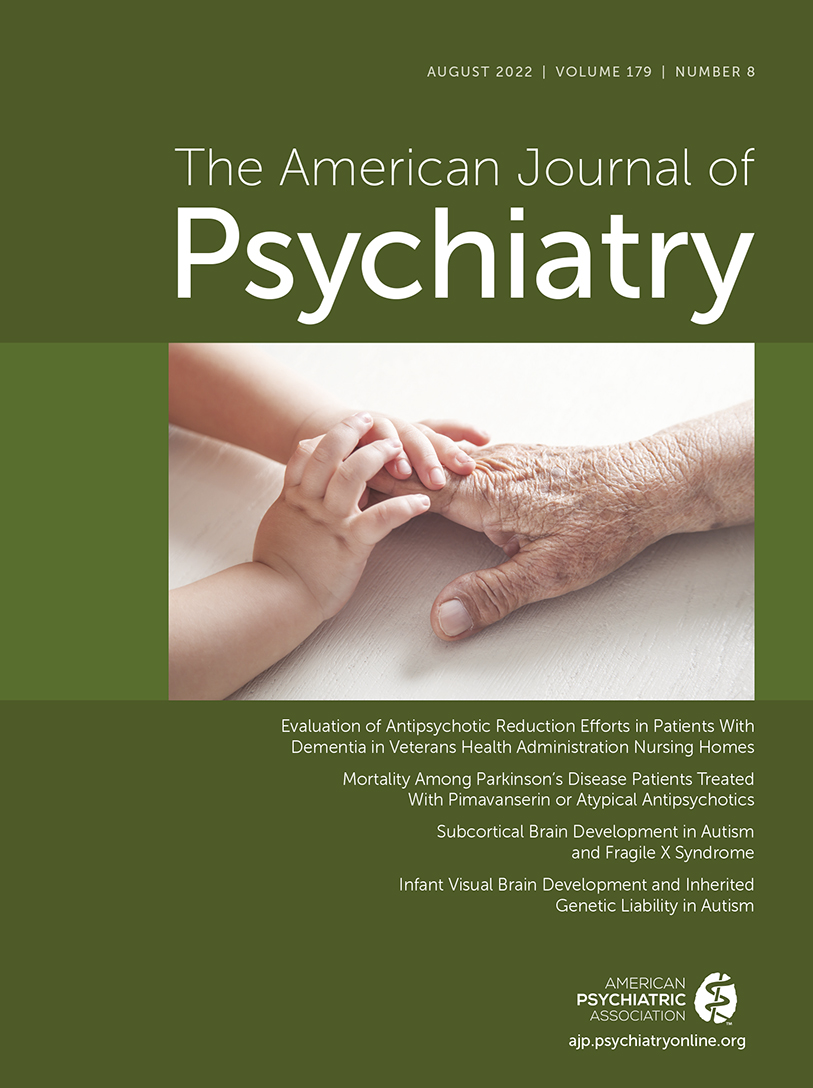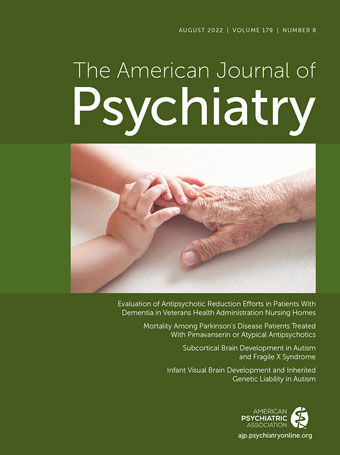The amygdala was among the very first structures found to be altered in individuals with autism spectrum disorder (ASD) (
1,
2). Previous MRI studies of the human amygdala have demonstrated that it undergoes a particularly long postnatal volumetric maturation, extending into adolescence (
3–
6). Perhaps one of the most highly replicated MRI findings in autism is that the amygdala demonstrates an early increase in volume relative to age-matched nonautistic control subjects (
5,
7–
9). These earlier studies indicate that the amygdala is already larger by around 3 years of age and continues to expand faster than in nonautistic control children for several years thereafter, at least in a substantial subset of autistic children.
The study by Shen et al. reported in this issue (
10) has provided important new information on the altered growth of the amygdala in ASD during infancy, prior to the behavioral diagnosis of ASD at 24 months of age. Supported by the unique resource of the Infant Brain Imaging Study (IBIS), which follows infants who have a higher likelihood for ASD by nature of having an older autistic sibling, from 6 to 24 months of age, Shen et al. evaluated amygdala development across infancy at three time points—6, 12, and 24 months of age. In the group of children ultimately diagnosed with ASD, they found that amygdala volume at 6 months did not differ significantly from in the nonautistic children. But the amygdala demonstrated more rapid enlargement between 6 and 24 months in the autistic children and was larger than in the nonautistic children at both 12 and 24 months. The authors conclude that in autistic children, the altered trajectory of amygdala growth begins during infancy, when the behavioral characteristics that will ultimately lead to a diagnosis of autism at 24 months are emerging.
A second contribution of the Shen et al. study was to address the issue of whether altered amygdala development occurs in other neurodevelopmental disorders. To do this, they carried out a similar analysis in children diagnosed with fragile X syndrome. In this group, they found no evidence of altered amygdala growth or of increased amygdala volume. In contrast, the caudate nucleus and related basal ganglia structures were enlarged even at the first imaging time point, when the children were 6 months of age. The findings thus highlight very different patterns of altered brain development in these two neurodevelopmental disorders. One remaining question is whether children with fragile X syndrome and co-occurring autism demonstrate a different amygdala trajectory from those with fragile X syndrome only. Also, given that previous studies have found smaller amygdala volume in preschool-age children with fragile X syndrome compared to nonautistic and autistic children (
11), the question of when amygdala development diverges in fragile X syndrome remains open.
A final point made by Shen et al. is that the rapid amygdala growth in autistic children was associated with increased social impairment as measured with the social affect component of the Autism Diagnostic Observation Schedule calibrated severity score but not with the restricted, repetitive behaviors severity score. This is consistent with previous studies indicating a link between altered amygdala development and the social impairments of ASD (
7,
9,
12). However, the role of the amygdala in social behavior and in the alterations of social behavior in autism remains murky.
Based on nonhuman primate studies, we have argued (
13) that the amygdala may play a limited role in the development and regulation of species’ typical social behavior. This view is supported by studies of patients with Urbach-Wiethe syndrome who have complete bilateral loss of the amygdala (
14,
15). These individuals do not have social perceptual deficits similar to those in autistic individuals and are not diagnosed with ASD. They do, however, demonstrate profoundly altered fear responses and reduced anxiety (
16), which is similar to what is observed in nonhuman primates with amygdala lesions (
17). The amygdala is clearly involved in the mediation of fear responses and in the manifestation of anxiety in humans (
18–
21). Considering the role of the amygdala in anxiety can potentially provide greater insight into the relationship between altered amygdala development and autism, but the situation is complicated.
Our group recently showed (
22) that 69% of a large cohort of autistic children who were followed longitudinally from early diagnosis (∼3 years of age) into middle childhood (∼11 years of age) also have a co-occurring anxiety disorder. However, there were various forms of anxiety among them: 21% had DSM-specified anxiety disorders, 17% had autism-related “distinct” anxiety, and 31% had both forms. Distinct anxiety refers to forms of anxiety distinctly related to autism, including idiosyncratic fears, fear relating to social confusion, special interest fears, and fears of change. A longitudinal analysis of amygdala development across early childhood (
23) indicated that the amygdala was larger across childhood only in those with co-occurring DSM-specified anxiety. In contrast, children with autism-distinct anxiety presentations at 11 years of age had smaller right amygdala volume at age 3 and a slower trajectory of amygdala development, resulting in persistently smaller amygdala volume in middle childhood. This is consistent with our previous work (
8), where we found that while a substantial subset of autistic children exhibited an increased rate of amygdala growth during early childhood (37–50 months of age), a small but meaningful subset also demonstrated slower-than-expected amygdala growth. This highlights the high degree of heterogeneity in both the behavioral presentation and the biology of autism as well as the need to consider subgroups of autistic children. Another important variable to consider is biological sex. Shen et al. report main effects of sex in amygdala development, but a relatively small number of autistic females in the sample (N=12) limits the ability to reliably detect sex differences. So, while there is little question that the development of the amygdala is altered in autism, how different patterns of amygdala development are related to social impairments, anxiety, or both remains unresolved.
A second unresolved issue is the biology underlying the altered trajectory of development of the amygdala. As Shen et al. recount, there is postmortem stereological evidence that in autistic individuals the amygdala has a higher number of neurons in the early years and a lower number in adulthood (
24). Whether there is an actual degenerative component to the lower cell number in later years is not possible to determine with available evidence. There is evidence from nonhuman primate studies indicating substantial plasticity of amygdala development that may be germane to an understanding of altered amygdala trajectory in autistic individuals. For example, it has been known for some time that the paralaminar nucleus of the amygdala harbors a large population of immature neurons (
25–
28). These appear to be the substrate for substantial morphological plasticity in the postnatal amygdala. In nonhuman primates that had undergone early lesions of the hippocampal formation, the number of mature neurons was 40% higher in the lateral and basal nuclei of the mature animals and 70% higher in the paralaminar nucleus. The paralaminar nucleus appeared to be repopulated with immature neurons, since the number was 40% higher in the adult amygdala of the neonatally lesioned animals. A fruitful area for future analysis of the postmortem human brain will be to determine whether the regulation of the paralaminar nucleus of the amygdala is particularly altered in ASD. Research on the nonhuman primate has also emphasized the complexity of the amygdala, which comprises no fewer than 13 subnuclei and cortical areas (
29). MRI analysis of the autistic amygdala has not yet taken this complexity into consideration.
The report by Shen et al. highlights the fact that alterations of amygdala development are certainly one prominent component of the neurophenotype of ASD, and, importantly, they are present by 12 months of age, well before behavioral diagnosis of ASD can reliably be made. However, it should not be expected that the amygdala will be involved in the same way across all autistic individuals. What differentiates those with and without amygdala alterations and how this maps onto both their core and co-occurring symptoms will be productive areas of future research. Since individuals with fragile X syndrome do not have clear volumetric alterations of amygdala development during infancy but nonetheless demonstrate substantial symptoms of anxiety (
30), the underlying neurobiological alterations leading to similar behavioral phenotypes in different neurodevelopmental disorders may be quite diverse. In the end, the paper by Shen et al. emphasizes the value of longitudinal studies, particularly in infancy, prior to the behavioral diagnosis of autism, and of the benefits of the enormous effort put forward by the IBIS network of investigators.

